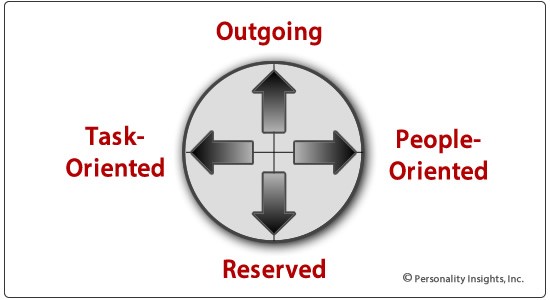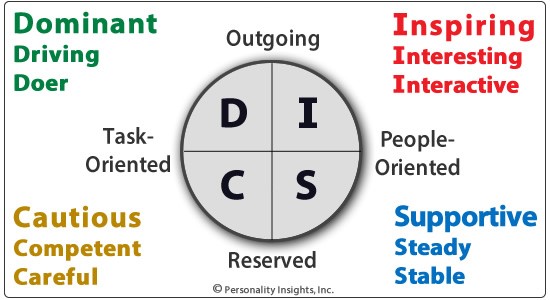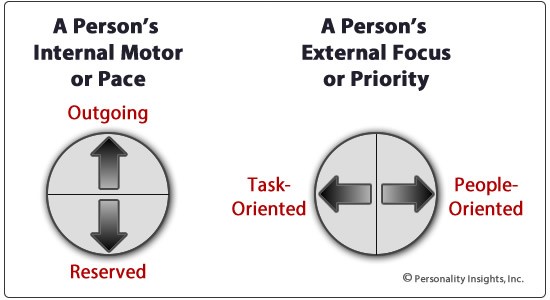Understanding DISC Part 2: Looking At The DISC Model of Human Behavior
The DISC Model of Human Behavior is based on 2 foundational observations about how people normally behave:
Observation #1: Some people are more OUTGOING, while others are more RESERVED.
You can think of this trait as each person’s “internal motor” or “pace.” Some people always seem ready to “go” and “dive in” quickly. They engage their motor quickly. Others tend to engage their motor more slowly or more cautiously.
Observation # 2: Some people are more TASK-ORIENTED, while others are more PEOPLE-ORIENTED.
You can think of this as each person’s “external focus” or “priority” that guides them. Some people are focused on getting things done (tasks); others are more tuned-in to the people around them and their feelings.
With both observations, we want to emphasize that these behavioral tendencies are neither right or wrong or good or bad. They are just different. We are simply identifying normal behavior styles. People have different styles, and that is okay. We represent these 2 observations in the diagrams below.
Four Major Personality Traits
In review, we have 4 behavioral tendencies to help us characterize people:
- Outgoing
- Reserved
- Task-oriented
- People-oriented
Everyone has some of all 4 of these tendencies at different times and in different situations. However, most people typically have 1 or 2 of these tendencies that seem to fit them well in their everyday behavior. And, on the other hand, 1 or 2 of these tendencies usually do not fit them well, and these tendencies may even seem “foreign” to their approach to life. The balance of these 4 tendencies shapes the way each person “sees” life and those around them. By combining the 2 previous diagrams, we can show 4 basic quadrants of the circle as shown below:
Four Major Personality Traits / Tendencies

Thus, 4 basic personality traits emerge from our diagram corresponding to the 4 quadrants of the circle (In clockwise order):
- Outgoing and Task-oriented (upper left quadrant)
- Outgoing and People-oriented (upper right quadrant)
- Reserved and People-oriented (lower right quadrant)
- Reserved and Task-oriented (lower left quadrant)
I happen to be outgoing and people-oriented. That would put me in the upper right quadrant..
Next, we will add descriptive terms for each of the four main personality types that emerge in the diagram. The descriptive terms will begin with D, I, S and C.
Describing Each Personality Style (4 Different Types – 4 Different Priorities)
As mentioned before, we will add the descriptive terms to the diagram. Notice the letters D, I, S and C appear in the 4 quadrants of the circle in the diagram below. You will also notice that descriptive terms have been added in each of the 4 corners of the diagram.
D-I-S-C Descriptive Terms

Now we can further describe each of the four main personality styles:
The Dominant “D” type – An outgoing, task-oriented individual will be focused on getting things done, accomplishing tasks, getting to the bottom line as quickly as possible and MAKING IT HAPPEN! (The key insight in developing a relationship with this type person is RESPECT and RESULTS.)
The Inspiring “I” type – An outgoing, people-oriented individual loves to interact, socialize and have fun. This person is focused on what others may think of him or her. (The key insight in developing a relationship with this type person is ADMIRATION and RECOGNITION.)
The Supportive “S” type – A reserved, people-oriented individual will enjoy relationships, helping or supporting other people and working together as a team. (The key insight in developing a relationship with this person is FRIENDLINESS and SINCERE APPRECIATION.)
The Cautious “C” type – A reserved, task-oriented individual will seek value, consistency and quality information. This person focuses on being correct and accurate. (The key insight in developing a relationship with this individual is TRUST and INTEGRITY.)
Now you know where the DISC concept came from and the importance of having a positive, flexible approach. Our next blog talks about your PQ, or Personality Quotient using the DISC Model of Human Behavior!
For more information about DISC, or to inquire how Alex can help your business increase sales and build better teams, simply fill out the contact information below. Thanks for stopping by! (Find Part 1 HERE)
Alex Swire-Clark
The Rapport Advantage™
Connect Quicker With People, Close More Sales, Build Better Teams









